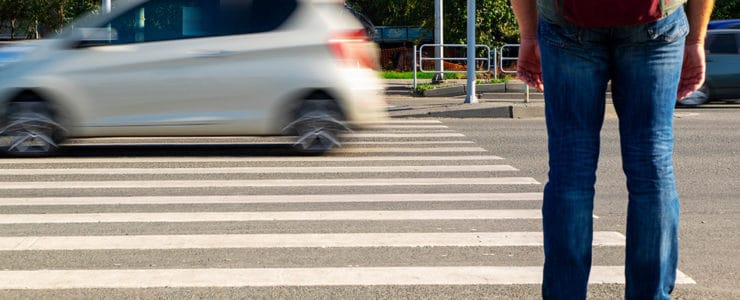
This Nevada Revised Statute involves a common saying all drivers hear and that is “right of way”. The right-of-way is very important because it really determines who is at fault if there is ever an accident. This particular NRS is specific to the right-of-way regarding crosswalks, drivers being obedient to vehicle control devices, and impeding other drivers.
Whether there is a revised statute or not, there are certain things you should do as a driver to help prevent getting a traffic ticket or causing an accident. Regardless of who has the right of way in a specific situation, you should always watch out.
Driving defensively, which is really just assuming that other drivers are not abiding by the rules of the road, is good practice. Another recommendation is to simply slow down. Driving fast makes it more difficult to make abrupt changes when things happen. So many accidents can be avoided if only drivers slowed down. Posted speed limits are set with safety in mind and should be adhered to.
If you are ever cited for speeding or for violating NRS 484B.283 you should call Ticket Busters for assistance. Our firm is fully equipped to assist you in any traffic or criminal allegation.
Pedestrians Have the Right of Way
When approaching crosswalks, pedestrians have the right-of-way.
Even in scenarios outside of a crosswalk, say for instance a pedestrian jaywalking across the street, drivers should still allow them to cross safely. If there was an accident, the driver most likely would not be cited but in any case, no one would want that on their conscience that they hit someone and possibly severely injured or killed them.
School Zones
Crossings near schools should always be driven through carefully. Many young people are around and they often do not pay attention to their surroundings. Little school children are not aware of driving rules either.
In many cases, there will be an adult volunteer monitoring the crosswalk but they can’t always control all of the children so driving extremely slow in these areas is very important. As a driver, you should always look in all directions before proceeding.
There is also a specific law about speeding in a school zone, so always keep this in mind.
Other Crosswalks
Aside from school zones, other crosswalks can have other types of people crossing them. Elderly pedestrians can take an extra long time to cross a street. The same goes for someone disabled or in a wheelchair.
With homeless populations increasing tenfold in recent years, there are many more of them at Las Vegas intersections. They can often be seen begging for money and will sometimes do so in the street.
Again, driving slowly and allowing for additional time for pedestrians to cross is a best practice. Basically, don’t be in a rush and if you are behind schedule be aware that driving faster isn’t really going to make up significant time and will in some cases just cause more delay if you get pulled over by a Las Vegas Metro police officer for violating a rule of the road.
Common Situations Where Drivers Are Asked to Take Extra Precaution
Drivers turning right into an intersection and properly yield to pedestrians as they make their way across the intersection. Drivers are supposed to wait until those pedestrians are at a safe distance prior to making the turn but often drivers will make their right-hand turn as soon as the pedestrian is just a car length away. If witnessed by a law enforcement offer, a driver could be cited.
Another observation is those on bikes. Bike riders should walk their bike across an intersection but many do not and simply ride it across. That has the potential to cause issues because it is more difficult and time-consuming for someone on a bike to react to a dangerous situation than if they were walking.
Drivers are also expected to exercise due care to bicyclists.
In any case, these situations can be avoided by simply slowing down.
What Does NRS 484B.283 Say
Let’s now look at the specifics of NRS 484B.283;
If a vehicle is stopped at a crosswalk that is properly marked or at an intersection, the driver of another car that may be approaching from the back of the first car cannot overtake and/or pass the idle car until the driver is assured that the automobile being overtaken was not stopped with the intent to cross the thoroughfare.
Any pedestrian is not allowed to abruptly leave a place of safety (such as a sidewalk or curb) and enter into the path of a vehicle that is so close that it makes the driver unable to yield.
Nevada Revised Statute 484B.283 has significant verbiage in it regarding traffic signals. The statute specifically reads:
Whenever signals exhibiting the words “Walk” or “Don’t Walk” are in place, such signals indicate as follows:
(a) While the “Walk” indication is illuminated, pedestrians facing the signal may proceed across the highway in the direction of the signal and must be given the right-of-way by the drivers of all vehicles.
In other words, when pedestrians get the electronic signal on the crosswalk to proceed, they should and can expect that drivers will give them the right-of-way. It’s pretty basic but if pedestrians have the green light to walk across the road then drivers need to abide by and allow them to do so.
Conversely, if the “Don’t Walk” light is on, pedestrians should not enter the crosswalk. With that said, if a pedestrian has already started crossing the street (when having been given the green light to go), and the light changes to “Don’t Walk” they should still have the right-of-way and be allowed to cross safely.
NRS484B.283 also has verbiage for the word “Wait” when it is lit up on a crosswalk. When this situation occurs, the “Wait” light has the same meaning per this statute as signage stating “Don’t Walk”.
Pulling directly from the statute again:
Whenever a signal system provides a signal phase for the stopping of all vehicular traffic and the exclusive movement of pedestrians, and “Walk” and “Don’t Walk” indications control pedestrian movement, pedestrians may cross in any direction between corners of the intersection offering the shortest route within the boundaries of the intersection when the “Walk” indication is exhibited, and when signals and other official traffic-control devices direct pedestrian movement in the manner provided in this section and in NRS 484B.307.
As in most statutes, the verbiage can be difficult to interpret as they are often written by lawyers and not the common person. This one basically says that in normal intersections, what we expect should happen is allowed!
So if we think of a popular intersection such as Tropicana and Rainbow Boulevards, we know that there are traffic lights in all four directions. We also know that there are crosswalks on all four sides with proper signals.
In this type of intersection where there are traffic control indicators for both vehicles and pedestrians, those that are attempting to cross the street are able to do so using the shortest route which is the safest option. With that said, those walking must stay within the boundaries of the marked crosswalk.
Revisiting what we wrote about previously in this article, there is verbiage in the statute that defines how far a pedestrian must be across the highway prior to a driver crossing the crosswalk:
When official traffic-control devices are not in place or not in operation the driver of a vehicle shall yield the right-of-way, slowing down or stopping if need be so to yield, to a pedestrian crossing the highway within a crosswalk when the pedestrian is upon the half of the highway upon which the vehicle is traveling, or when the pedestrian is approaching so closely from the opposite half of the highway as to be in danger.
Our observation written about earlier, discussed impatient drivers giving the right-of-way to pedestrians but not the proper amount of right-of-way. The example discussed drivers making a right-hand turn across a crosswalk, waiting for the walker to just get far enough away to avoid being hit and then the car proceeds.
Well, this snippet from NRS 484B.283 defines exactly how much room should be given to pedestrians in this type of situation when a traffic-controlled device is not operational or present.
In this case, the driver should not proceed until the pedestrian is at least half way across the road. Now, if there is a traffic device present signaling the signage for the pedestrian to “Walk” then cars need to wait until those signs change before moving forward.
If you are ever ticketed for a violation of this statute then let our professionals at Ticket Busters help you out. As we’ve written about in this article, there are many variables in these scenarios and our defense team will investigate all of them.
One example is to ensure that traffic signals were all operational at the time you were cited. We can also research to see if the devices were even present and what directive they were signaling at the moment.


